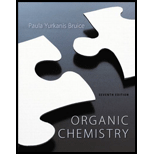
(a)
Interpretation:
Mechanism for the given reaction should be proposed.
Concept Introduction:
Unimolecular nucleophilic substitution reaction in which the reversible ionization of
If the leaving group in
An enantiomer, also known as an optical isomer, is one of two stereoisomers that are mirror images of each other that are non-superimposable.
(b)
Interpretation:
The formation of two products in the given reaction should be explained.
Concept Introduction:
Unimolecular nucleophilic substitution reaction in which the reversible ionization of alkyl halide in the presence of aqueous acetone or an aqueous ethyl alcohol provides a carbocation as an intermediate, attacked by the nucleophile to form the product.
If the leaving group in
An enantiomer, also known as an optical isomer, is one of two stereoisomers that are mirror images of each other that are non-superimposable.
(c)
Interpretation:
Reason for the single substation products obtained in the given reaction should be explained.
Concept Introduction:
Unimolecular nucleophilic substitution reaction in which the reversible ionization of alkyl halide in the presence of solvent provides a carbocation as an intermediate, attacked by the nucleophile to form the product.
If the leaving group in
An enantiomer, also known as an optical isomer, is one of two stereoisomers that are mirror images of each other that are non-superimposable.
Want to see the full answer?
Check out a sample textbook solution
Chapter 9 Solutions
Organic Chemistry; Modified MasteringChemistry with Pearson eText -- ValuePack Access Card; Study Guide and Student Solutions Manual for Organic Chemistry, Books a la Carte Edition (7th Edition)
- Show the mechanism steps to obtain the lowerenergy intermediate: *see imagearrow_forwardSoap is made by the previous reaction *see image. The main difference between one soap and another soap isthe length (number of carbons) of the carboxylic acid. However, if a soap irritates your skin, they mostlikely used too much lye.Detergents have the same chemical structure as soaps except for the functional group. Detergentshave sulfate (R-SO4H) and phosphate (R-PO4H2) functional groups. Draw the above carboxylic acidcarbon chain but as the two variants of detergents. *see imagearrow_forwardWhat are the reactions or reagents used? *see imagearrow_forward
- The two pKa values of oxalic acid are 1.25 and 3.81. Why are they not the same value? Show the protontransfer as part of your explanation. *see imagearrow_forwardасть Identify all the bonds that gauche interact with C-OMe in the most stable conformation of the above compound.arrow_forwardPredict the reactants used in the formation of the following compounds using Acid-Catalyzed dehydration reactionarrow_forward
- Can I please get help with this?arrow_forward.. Give the major organic product(s) for each of the following reactions or sequences of reactions. Show ll relevant stereochemistry [3 ONLY]. A H Br 1. NaCN 2 NaOH, H₂O, heat 3. H3O+ B. CH₂COOH 19000 1. LiAlH4 THF, heat 2 H₂O* C. CH Br 1. NaCN, acetone 2 H3O+, heat D. Br 1. Mg. ether 3. H₂O+ 2 CO₂ E. CN 1. (CH) CHMgBr, ether 2 H₂O+arrow_forwardAssign this COSY spectrumarrow_forward
 Organic Chemistry: A Guided InquiryChemistryISBN:9780618974122Author:Andrei StraumanisPublisher:Cengage Learning
Organic Chemistry: A Guided InquiryChemistryISBN:9780618974122Author:Andrei StraumanisPublisher:Cengage Learning
